Introduction
Potato production in Kenya is mainly concentrated in the highlands (1700-3000 m above sea level) where its production is more than other staple foods such as maize. The crop performs dual purpose of being both a cash and food crop thereby contributing immensely to the economy of the Kenyan population with the whole value chain indirectly employing about 2.5 million people including researchers, extension agents, seed inspectors, transporters, market agents, processors among players in the agricultural sub-sector.1,2
There exist over twenty varieties of potato in Kenya and some efforts have been made to identify suitable varieties for processing; these have been limited to a few storage regimes.3 Most potatoes harvested in the country are sold immediately after harvest with storage for future use rarely practiced despite the huge gluts and low prices experienced during the harvesting period and which is followed by scarcity and high prices a few months later, just before the next planting season.4 Inadequate storage facilities and knowledge are some of the factors limiting trade and utilization of the potato in Kenya.5
Varieties Tigoni, Ducth Robjin and Asante have been used for industrial processing and home made preparations, respectively. Kenya Mpya on the other hand is a recently released but promising processing variety. Shangi is one of the most popular varieties in Kenya that performs well both at industrial processing and home preparation. The variety is early maturing and is known to have high productivity hence its popularity with farmers. Shangi, however, has short dormancy making it difficult to store with the aim of future processing. This poses serious difficulties when it comes to storage for processing as sprouts emerge soon after harvesting. Establishing appropriate storage conditions for these popular processing varieties will not only ensure availability of adequate processing materials, but also food and economic security to many farmers who depend on potato production for their livelihoods.
Materials and Methods
Acquisition of potato tubers for storage
Tubers of four popular varieties namely, Tigoni, Dutch Robijn, Asante, Kenya Mpya and Shangi were grown at the National Potato Research Centre, Tigoni according to the standard cultural practices and harvested at maturity in 2013/2014. They were then delivered for storage trials at the Department of Food Science, Nutrition and Technology, University of Nairobi.
Tuber storage
Selected ware potato tubers were packaged in approximately 5 kg net bags and stored in duplicates under different temperature regimes in storage chambers exclusive of light. Temperature of storage included prevalent ambient (20-24 oC), 12-14 oC, 8-10 oC,4-6oC and relative humidity of 82-92%. Due to its low dormancy, tubers from variety Shangi were evaluated at intervals of two weeks for up to ten weeks, while the rest of the tubers were evaluated at intervals of one month for three months.
Establishing effect of storage on physico-chemical properties of stored potato tubers
The physico-chemical quality of the different potato varieties recommended for the study were determined to establish the best conditions for storage with minimum effect on important quality parameters. Laboratory evaluation of tuber quality traits included analysis of dry matter content, reducing sugars contents, vitamin C content (ascorbic acid content), and sprouting and weight loss.
Determination of dry matter content
Tuber dry matter content was determined by oven drying method as described by Abong’ et al.,3
Determination of reducing sugars content
Reducing sugars content was determined by the LuffSchoorl’s method as described by Abong’ et al.,6
Determination of ascorbic acid content
Ascorbic acid was determined as reduced ascorbic acid (RAA) as described by Abong’ et al.,6
Determination of sprout length
Sprout length was determined by measuring the highest emerging sprouts as described by Gachango et al.,7
Determination of weight loss
Potatoes were packaged into 5 kg bags in duplicate for weight loss determination. The bags were weighed at each interval and reduction in weight noted as a percentage according to Gachango et al.,7
Results and discussion
Variation of reducing sugars in stored potato tubers
Reducing sugars significantly (p<0.05) increased with time with the increase being pronounced at lower temperature. At harvest, the reducing sugars were 0.17 % in Shangi, this increased after 10 weeks of storage to 0.21 %, 0.31 %, 0.68 % and 0.89 % at ambient, 12-14 oC, 8-10 oC, 4-6 oC, respectively (Figure 1). The results imply that Shangi tubers can still be used to process crisps and French fries directly at ambient prevalent conditions storage even after 10 weeks while at 12-14 oC this can only be possible up to the 6th week when the sugars are still below 0.25% required for crisps processing.8 At subsequent lower temperatures, reducing sugars levels became much higher just after two weeks of storage and hence would require reconditioning before processing. The scenario was similar for Dutch Robijn, Asante, Kenya Mpya and Tigoni after a month of storage (Figure 2). Reducing sugars level is an important quality parameter in as far as potato tubers meant for processing are concerned. Total reducing sugars determine the colour and flavor of fried potato products.9,10 Higher than necessary reducing sugars will lead to darkening and hence burnt flavors of French fries, crisps and other fried products. Dark coloured potato products bring to question their safety since they have been shown to have high levels of acrylamide, a chemical known to be carcinogenic to animals but remains probable carcinogen to humans.11,12,13,14 Cold storage of potatoes below 10oC leads to conversion of starch to reducing sugars, the extent being dependent on temperature of storage and variety.15 In the current study, none of the tubers can be stored in cold temperature and directly be used for frying without proper reconditioning.
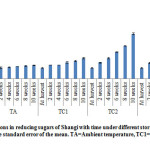 |
Figure 1: Variations in reducing sugars of Shangi with time under different storage temperatures. The bars indicate standard error of the mean. TA=Ambient temperature, TC1=12-14 oC, TC2=8-10 oC, TC3=4-6 oC. Click here to View figure |
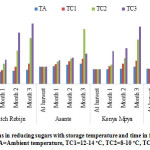 |
Figure 2: Variations in reducing sugars with storage temperature and time in four popular Kenyan potato varieties. TA=Ambient temperature, TC1=12-14 oC, TC2=8-10 oC, TC3=4-6 oC. Click here to View figure |
Changes in Vitamin C of stored potato tubers
Reduced ascorbic acid (vitamin C) in Shangi decreased significantly (p<0.05) with storage time irrespective of storage temperature, from 77.1 mg/100 g at harvest to 52 mg/100 g, 51 mg/100 g, 50 mg/100 g and 40 mg/100 g at ambient, 12-14 oC, 8-10 oC and 4-6 oC, respectively (Figure 3). The reduction was highest at the lowest storage temperature and seemed to be linear with time compared to ambient storage where the rate of reduction levels off after 8 weeks. In Dutch Robijn, highest retention was in tubers stored at 8-10 oC. Asante which had the highest levels of vitamin C at harvest retained most of it under prevalent temperature and 12-14 oC, while Tigoni and Kenya Mpya had higher retention at prevalent temperature of storage (Figure 4).
Vitamin C is an essential vitamin important for collagen formation and hence cause of scurvy if deficient in human diet. It is also critical when it comes to protection against oxidative stress as an antioxidant [16]. The vitamin is abundant in fruits and vegetables, potatoes have been known as important source of the vitamin. It is, however, a labile vitamin affected by potato variety, changes in temperature and other environmental conditions.17,18,19 The levels of vitamin C in the current study are higher in raw tubers compared to those reported by Abong et al.,20 on four Kenyan genotypes, but the range is similar to those reported by Burgos et al.,21 Asante and Shangi had the highest levels of vitamin C and hence the highest retention. It should, however, be noted that Shangi would store for shorter period than other tubers.
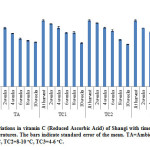 |
Figure 3: Variations in vitamin C (Reduced Ascorbic Acid) of Shangi with time under different storage temperatures. The bars indicate standard error of the mean. TA=Ambient temperature, TC1=12-14 oC, TC2=8-10 oC, TC3=4-6 oC. Click here to View figure |
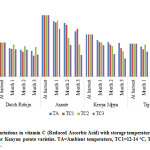 |
Figure 4: Variations in vitamin C (Reduced Ascorbic Acid) with storage temperature and time in four popular Kenyan potato varieties. TA=Ambient temperature, TC1=12-14 oC, TC2=8-10 oC, TC3=4-6 oC. Click here to View figure |
Changes in dry matter content of stored potato tubers
Dry matter content varied significantly (p<0.05) with storage temperature and time, it increased in Shangi after 10 weeks of storage from 18.9 % to 28.09 %, 26.43 %, 23.33 % and 23.02 % at ambient, 12-14 oC, 8-10 oC and 4-6 oC, respectively (Figure 5). Prevalent ambient storage seemed to have higher increase in dry matter compared to lower temperature storage as a result of high dehydration and the reverse was observed in low temperature storage. The increase in dry matter was more pronounced (p<0.05) in Asante and Kenya Mpya than Dutch Robijn and Tigoni varieties (Figure 6).
Dry matter is critical in potatoes meant for processing as it determines yield, texture and oil content of fried products.22,23 The higher the dry matter the more the yield for the processor. On the other hand, farmers or traders who sell potatoes on weight basis may be at a disadvantage as they will be selling less weight after storage. As such varieties Dutch Robijn and Tigoni would be beneficial to store with the aim of late sales.
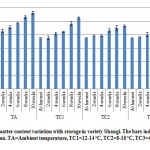 |
Figure 5: Dry matter content variation with storage in variety Shangi. The bars indicate standard error of the mean. TA=Ambient temperature, TC1=12-14 oC, TC2=8-10 oC, TC3=4-6 oC Click here to View figure |
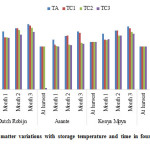 |
Figure 6: Dry matter variations with storage temperature and time in four popular Kenyan varieties Click here to View figure |
Variations in sprouting and weight loss in tubers under different storage conditions. TA=Ambient temperature, TC1=12-14 oC, TC2=8-10 oC, TC3=4-6 oC.
Variations in weight loss and sprouts of stored potato tubers
Weight loss was minimal under all the storage conditions being less than 5%. Sprouting however, increased significantly with storage time and with increased storage temperature. At ambient temperature and 12-14 oC, sprouts emerged in Shangi after 2 weeks of storage and increased steadily with time reaching 43 mm after 10 weeks (Figure 7). The sprouts emerged 4 and 8 weeks at 8-10 oC, 4-6 oC, respectively. There was minimal sprouting (6.5 mm) after 10 weeks of storage at 4-6 oC. Sprouts emerged after 2 months of storage of Dutch Robijn, Kenya Mpya and Asante being pronounced at 12-14 oC and ambient storage. Limited sprouting was observed at lower temperatures of storage.
Sprouts are desirable when one considers seed potato tubers in which case the vigor and quality of the same becomes critical.7 For ware potatoes, however, sprouts are undesirable as they indicate breakdown of the dormancy and hence reduced tuber suitability for use in processing. Storage at low temperature is effective in controlling sprouts as indicated in the current study and should be adopted.
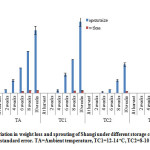 |
Figure 7: Variation in weight loss and sprouting of Shangi under different storage conditions. The bars indicate standard error. TA=Ambient temperature, TC1=12-14 oC, TC2=8-10 oC, TC3=4-6 oC. Click here to View figure |
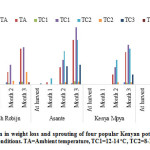 |
Figure 8: Variation in weight loss and sprouting of four popular Kenyan potato varieties under different storage conditions. TA=Ambient temperature, TC1=12-14 oC, TC2=8-10 oC, TC3=4-6 oC. Click here to View figure |
Acknowledgements
Funds used to carry out the current study were provided by Syngenta East Africa. The authors appreciate the role of National Potato Research Centre in provision of potatoes used in the study.
References
- Gildemacher P.R., Kaguongo W., Ortiz O., Tesfaye A., Woldegiorgis G., Wagoire W.W., Kakuhenzire R., Kinyae P.M., Nyongesa M., Struik P.C. & Leeuwis C., Improving Potato Production in Kenya,Uganda and Ethiopia: A System Diagnosis, Potato Research, 52, 173–205 (2009).
CrossRef - Abong’ G.O. and Kabira J.N., The current status of the potato value chain in Kenya In: Trends and opportunities in the production, processing and consumption of staple foods crops in Kenya, TUD Press, Dresden, Germany, 56-59 (2013).
- Abong’ G.O., Okoth M.W., Karuri E.G., Kabira J.N and Mathooko F.M., Levels of reducing sugars in eight Kenyan potato cultivars as influenced by stage of maturity and storage conditions, Journal of Animal and Plant Sciences, 2 (2), 76 – 84 (2009a).
- Walingo A., Lung’aho C., N’gang’a N., Kinyae P.M. and Kabira J.N., Potato marketing, storage, processing and utilization in Kenya. Proceedings of 6th Triennial congress of the African potato Association, Agadir, Morocco, 5-10 April (2004).
- Abong’ G.O., Okoth M.W. and Kabira J.N., Characteristics of fresh (ware) potato traders in Nairobi and Nakuru towns, Kenya In: Contribution of agriculture to achieving MDGs, IeCAB2010 – eBook. FaCT: Published online at http://www.m.elewa.org, 141-147 (2010a).
CrossRef - Abong’ G.O., Okoth M.W., Imungi J.K. and Kabira J.N., Evaluation of selected Kenyan potato cultivars for processing into potato crisps, Agriculture and Biology Journal of North America, 1 (5), 886-893 (2010b).
- Gachango E., Solomon I.S., Kabira J.N., Chemining’wa G.N. and Demo P., Effects of light intensity on quality of potato seed Tubers, African Journal of Agricultural Researh, 3 (10), 732-739 (2008).
- Kabira J.N and Lemaga B., Potato Processing: Quality Evaluation procedures for research and food industries applications in East and Central Africa. Kenya Agricultural Research Institute, Nairobi, Kenya (2006).
- Mendoza F., Dejmek P. and Aguilera J.M., Colour and image texture analysis in classification of commercial potato chips, Food Research International, 40, 1146-1154 (2007).
CrossRef - Abong’ G.O., Okoth M.W., Imungi J.K. and Kabira J.N., Effect of slice thickness and frying temperature on colour, texture and sensory properties of crisps made from four Kenyan potato cultivars, American Journal of Food Technology, 6 (9), 753-762 (2011a).
CrossRef - Mottram D., Wedzicha B., and Dodson A., Acrylamide is formed in the Maillard reaction, Nature, 419, 448–449 (2002).
CrossRef - Stadler R. H., Robert F., Riediker S., Varga N., Davidek T., and Devaud S., In-depth mechanistic study on the formation of acrylamide and other vinylogous compounds by the Maillard reaction, Journal of Agricultural and Food Chemistry, 52, 5550–5558 (2004).
CrossRef - Ghanayem B.I., Witt K.L., El-Hadri L., Hoffler U., Kissling G.E., Shelby M.D. and Bishop J.B., Comparison of germ cell mutagenicity in male CYP2E1-null and wildtypemice treated with acrylamide: evidence supporting a glycidamide mediated effect, Biology of Reproduction, 72, 157–163 (2005).
CrossRef - Bongers M.L, Hogervorst J.G.F, Schouten L.J., Goldbohm R.A., Schouten H.C., Goldbohm R.A., and van den Brandt P.A., Dietary Acrylamide Intake and the Risk of Lymphatic Malignancies: The Netherlands Cohort Study on Diet and Cancer, PLoS ONE, 7 (6), e38016 (2012).
CrossRef - Kumar D., Singh B.P. and Kumar P., An overview of the factors affecting sugar contentof potatoes. Central Potato Research Institute, Ann, Applied Biology, 145, 247-256 (2004).
CrossRef - Badreh F., Abbasnejad M., Derakhshani A. And Jonaidi H., Interaction between ascorbic acid and dopamine D receptor in the nucleus accumbens shell in response to feeding, International Journal of Biology and Chemistry, 3, 132-141 (2009).
CrossRef - Han J.S., Kosukue N., Young K.S., Lee K.R. and Friedman, M., Distribution of ascorbic acid in potato tubers and in home-processed and commercial potato foods, Journal of Agriculture and Food Chemistry, 52 (21), 6516–6521 (2004).
CrossRef - Hamouz K., Lachman L., Dvorak, P., Orsak M., Hejtmankova K. and Cizek, M., Effect of selected factors on the content of ascorbic acid in potatoes with different tuber flesh colour, Plant Soil Environment, 55 (7), 281–287 (2009).
- Hemavathi C., Upadhyaya P., Akula N., Young K.E., Chun S.C., Kim D.H., and Park S.W., Enhanced ascorbic acid accumulation in transgenic potato confers tolerance to various abiotic stresses, Biotechnology Letters, 32 (2), 321-330 (2010).
CrossRef - Abong’ G.O., Okoth, M.W., Imungi, J.K. and Kabira, J.N., Losses of ascorbic acid during storage of fresh tubers, frying, packaging and storage of potato crisps from four Kenyan potato cultivars, American Journal of Food Technology, 6 (9), 772-780 (2011b).
CrossRef - Burgos G., Auqui S., Amoros W., Salas E. and Bonierbale M., Ascorbic acid concentration of native Andean potato varieties as affected by environment, cooking and storage, Journal of Food Composition Analysis, 22, 533–538 (2009).
CrossRef - Burton W.G., The potato.3rd ed. Longman Group United Kingdom, 286-360 (1989).
- Abong’ G.O., Okoth M.W., Karuri E.G., Kabira J.N. and Mathooko F.M., Influence of potato cultivar and stage of maturity on oil content of French fries made from eight Kenyan potato cultivars, African Journal of Food Agriculture Nutrition and Development, 9 (8), 1667-1682 (2009b).
CrossRef

This work is licensed under a Creative Commons Attribution 4.0 International License.





